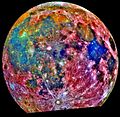| KuvausMoon - False Color Mosaic.jpg |
English: Original Caption Released with Image: This false-color photograph is a composite of 15 images of the Moon taken through three color filters by Galileo's solid-state imaging system during the spacecraft's passage through the Earth-Moon system on December 8, 1992. When this view was obtained, the spacecraft was 425,000 kilometers (262,000 miles) from the Moon and 69,000 kilometers (43,000 miles) from Earth. The false-color processing used to create this lunar image is helpful for interpreting the surface soil composition. Areas appearing red generally correspond to the lunar highlands, while blue to orange shades indicate the ancient volcanic lava flow of a mare, or lunar sea. Bluer mare areas contain more titanium than do the orange regions. Mare Tranquillitatis, seen as a deep blue patch on the right, is richer in titanium than Mare Serenitatis, a slightly smaller circular area immediately adjacent to the upper left of Mare Tranquillitatis. Blue and orange areas covering much of the left side of the Moon in this view represent many separate lava flows in Oceanus Procellarum. The small purple areas found near the center are pyroclastic deposits formed by explosive volcanic eruptions. The fresh crater Tycho, with a diameter of 85 kilometers (53 miles), is prominent at the bottom of the photograph, where part of the Moon's disk is missing.
Deutsch: Diese Falschfarbenfotografie ist aus 15 Bildern des Mondes, die durch drei Farbfilter mit der Kamera der Galileo-Sonde während der Durchquerung des Erde-Mond-Systems am 8. Dezember 1992 aufgenommen wurden, zusammengesetzt. Als diese Ansicht aufgenommen wurde, war die Sonde 425.000 Kilometer vom Mond und 69.000 Kilometer von der Erde entfernt. Die Falschfarbendarstellung erleichtert die Interpretation der Oberflächenzusammensetzung des Mondes. Regionen, die rot erscheinen, sind im Allgemeinen Hochlandgebiete, während blaue bis orangefarbene Schattierungen alte vulkanische Lavaflüsse der Mare anzeigen. Blauere Mare enthalten mehr Titan als die orangefarbenen Regionen. Das Mare Tranquilitatis, als dunkelblaue Fläche auf der rechten Seite zu erkennen, enthält mehr Titan als das Mare Serenitatis, eine etwas kleinere kreisförmige Fläche, die sich unmittelbar oben links an das Mare Tranquilitatis anschließt. Blaue und orangefarbene Gebiete, die viel von der linke Seite des Mondes in dieser Darstellung bedecken, stellen viele einzelne Lavaflüsse im Oceanus Procellarum dar. Dei kleine purpurnen Gebiete nahe der Bildmitte sind pyroklastische Ablagerungen, die bei explosiven vulkanischen Eruptionen entstanden. Der junge Krater Tycho, mit einem Durchmesser von 85 Kilometer ist deutlich am unteren Rand des Fotos zu sehene, wo Teile der Mondscheibe fehlen.
Español: Esta fotografía en falso color es un compuesto de 15 imágenes de la Luna tomadas a través de tres filtros de color por el sistema de imágenes de estado sólido de Galileo durante el paso de la nave a través del sistema Tierra-Luna el 8 de diciembre de 1992. Cuando esta vista se obtuvo, la nave espacial estaba a 425.000 kilómetros de la Luna y 69.000 kilómetros de la Tierra. El procesamiento de falso color utilizado para crear esta imagen lunar es útil para interpretar la composición del suelo de la superficie. Las áreas que aparecen rojas generalmente corresponden a las tierras altas lunares, mientras que las sombras azules a naranjas indican el antiguo flujo de lava volcánica o mar lunar. Las áreas más azules contienen más titanio que las regiones de color naranja. El Mar de la Tranquilidad, visto como un parche azul profundo a la derecha, es más rico en titanio que el Mar de la Serenidad, un área circular ligeramente más pequeña inmediatamente adyacente a la parte superior izquierda del primero. Las áreas azules y anaranjadas que cubren gran parte del lado izquierdo de la Luna en esta vista representan muchos flujos de lava separados en el Océano de las Tormentas. Las pequeñas áreas púrpuras que se encuentran cerca del centro son depósitos piroplásticos formados por explosivas erupciones volcánicas. El reciente cráter de impacto Tycho, con un diámetro de 85 kilómetros, es prominente en la parte inferior de la fotografía, donde falta parte del disco de la Luna. |





